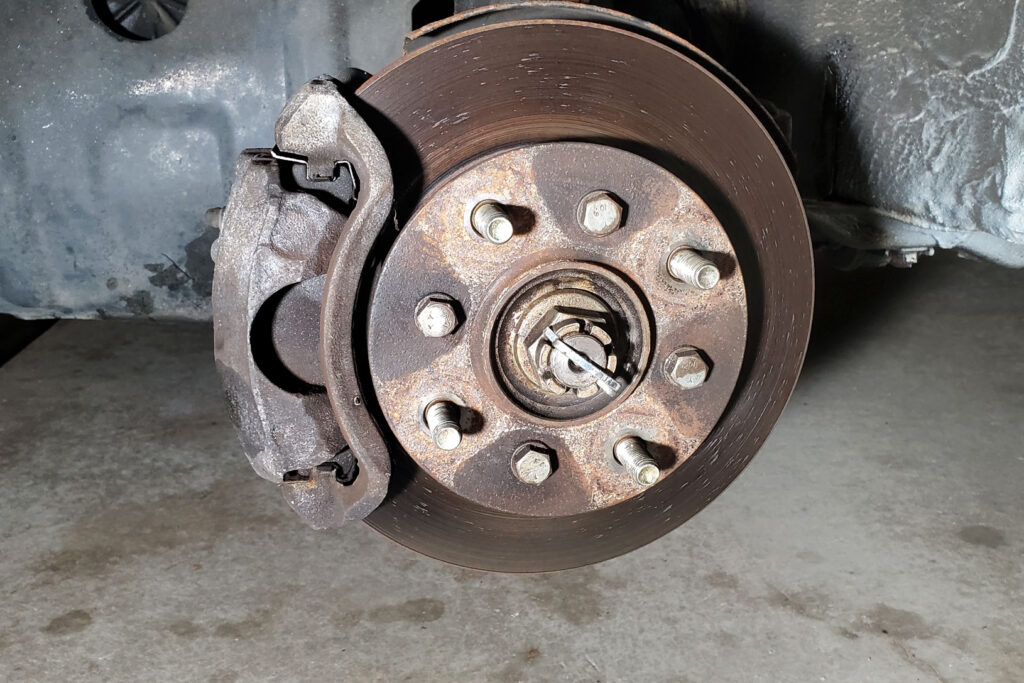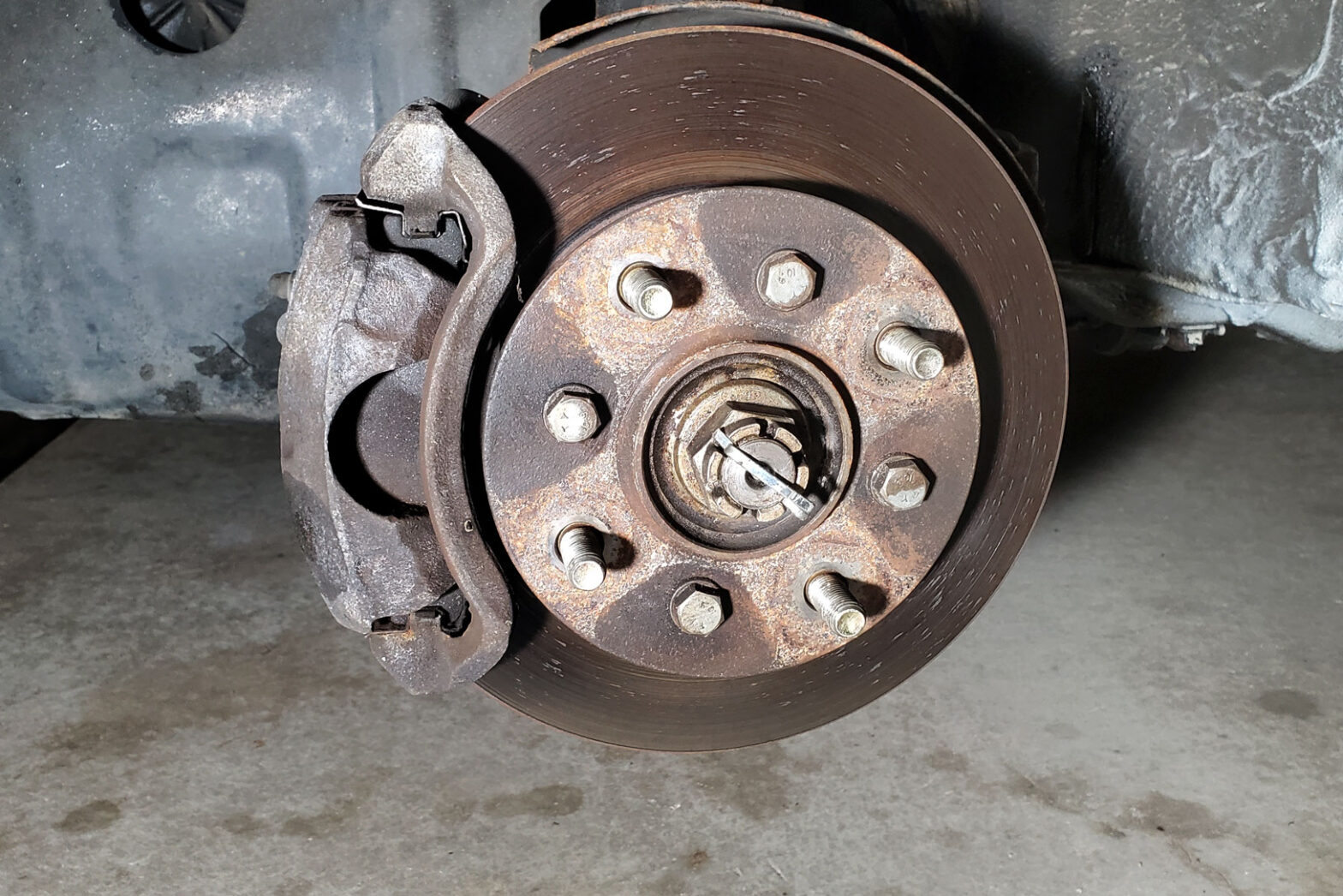Whenever I buy a used car, one of the first maintenance jobs I like to do is a full brake replacement. The kind of cars I buy usually have worn out brakes when I get them, so it’s often necessary for safety. The Accent’s brakes were a bit worn and rusty and, given the low mileage on this car, were likely the original rotors from the factory. I can normally do brakes myself. The parts are pretty affordable, and rotors, pads, and even drum brakes are not too difficult to remove and replace, in most cases. As I would soon discover, the front brakes on a 1998 Hyundai Accent are quite a lot more difficult than average.
Captive Rotors are Cursed
I bought all the parts I would need: new front rotors and pads, new rear drums and shoes. This cost me about $130.00. Then I pulled off the front wheels and was confronted with a puzzle: there are no set screws here. The rotor does not simply slip over the hub and wheel studs. Instead, it has four bolt heads protruding from it and there is no obvious way to separate it from the hub.

This is known as a captive rotor. The rotor is essentially part of the hub and you need to press (or pound) it out. In my mind, it’s a design that implies that the manufacturer did not expect the car to outlast the brakes. Considering how quickly these cars tend to rust, that doesn’t seem like an implausible scenario. There are tapered bearings in there as well, which are apparently a real pain to remove. Here’s some foreshadowing: they’re also tricky to replace.
I tried to use a brake drum puller to remove the brakes, which is the wrong tool for the job. All it did was push the axle shaft towards the transmission. I also tried a hammer on the backside of the disc (I read somewhere that this may work), but this also had no effect. If I had been successful with either of these methods, I would have been in even bigger trouble, because I doubt I could have put everything back together.
From the limited information I have found on the internet, it seems the “easiest” way to deal with all of this is to completely remove the knuckle from the car. I wasn’t about to do that, nor do I have a press or any sort of bearing removal tools, so after replacing the rear drums and shoes, I gave up on the front brakes and took it to a shop.
Hyundai Wheel Bearings are Cursed
Shop number one, who shall remain nameless, agreed to use my parts and replace the front rotors for me. Since this involves tearing apart the hub, I also had them replace the wheel bearings. About $640.00 later, I had new front brakes. This happened in mid-October of 2020, when the weather had already turned cool. This turned out to be an important part of the story, because as long as things stayed cool, there were no problems. If I drove long enough however, a strange noise developed: at higher speeds it was inaudible, but as I slowed down it turned into a squealing noise that became a strange creaking noise not unlike an old door turning on its hinges. I realized that something was happening as the car was heating up; there must have been some excessive friction that led to expansion, which then caused the noise.
I began to wonder if, in my attempts to pull, pry, or hammer the disc off, I had somehow damaged something inside the transmission. In retrospect this seems unlikely, but I didn’t think that this mechanic had been unable to replace a wheel bearing properly. It’s a pretty common job.
I took it to shop number two, who shall also remain nameless, because I was no longer sure I could trust the first shop. Kind of like getting a second opinion from another doctor, I guess. I had explained to them that they would need to drive it for a while, until it heated up sufficiently, to verify that there was no noise after they fixed things. They took it apart and told me they had to replace… the wheel bearings, which I thought was very strange because I had just had that done. Another $480.00 later, I got the car back and everything seemed fine. This was in mid-November, so the weather was even colder. I drove the car for a long time to make absolutely sure the noise was gone and… it wasn’t.
At this point I was beginning to suspect that I had, in fact, done some damage to the transmission. How could two different shops have made the same mistake when installing simple wheel bearings? Still, the colder weather kept the problem at bay so I decided to just leave it alone and drive the car as-is for a while.
Just Take it to the Pros
Warmer weather arrived and it was squealing constantly. I kept putting it off and just not driving very often until late August of 2021. At this point I no longer trusted anyone with the car except the Hyundai dealership mechanics. I gave them the whole story and told them I suspected something major. A few days later they called me back and told me they had to replace… the wheel bearings. Imagine my disbelief; this was the third time the wheel bearings had been replaced. Had they just not driven the car enough to hear the squealing and assumed it was fixed?
When I picked up the car, I had the opportunity to speak with the service technician who had worked on my car, and he showed me the bearings he had removed. Spinning them in my hand, it was easy to feel some “bumps” as it rotated. These were flat spots in the bearings that were caused by over-torquing the spindle nuts. Remember earlier how I said they are difficult to replace? If you approach this job like it’s a Honda and just torque the spindle nuts down to whatever the maximum spec is, you will deform the tapered wheel bearings. Instead it requires a tricky procedure that’s more art than science, which I think involves rotating the wheel while you tighten the nut. That’s what my (not very detailed) Chilton service manual says at least. Clearly the dealer’s service tech had the requisite experience, because the wheel no longer squeals. That was another $650.00.
This was definitely one of those jobs where it would have just been cheaper to take it to the professionals the first time. It’s hard to know when this will be the case; sometimes you can figure it out yourself and if not, you can usually expect a decent local shop to get the job done right. But sometimes, you spend $1900 on a job that should have cost $130 and a few hours of your time. Thankfully, this was the only major mechanical issue I have had with this car.
I think I’ll be leaving these brakes on for as long as possible.
